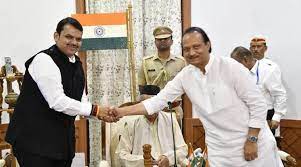In phase one of the LS elections, Maharashtra has poor voter participation in five seats, which worries the BJP and Congress
Tensions between the BJP and Congress have escalated as a result of the poor voter participation in all five of Maharashtra’s Lok Sabha seats that were up for election in the first round.

The combined voting percentage for the five constituencies was 57.82 percent.
It’s interesting to note that, out of the five seats, the district Gadchiroli, which is impacted by the Naxalite movement and tribe, had the highest vote percentage (66.3%).
However, the number decreased by 6.03% when compared to the general sections for 2019.
In the Gadchiroli seat, the Congress has put Dr. Namdev Kirsan up against Ashok Nete, the current Lok Sabha MP for the BJP.
Lok Sabha seat of Nagpur
In the meanwhile, 51.54% of voters cast ballots in Nagpur, where Union Minister Nitin Gadkari is running for a third term against Congressman Vikas Thakre, as opposed to 57.8% in the 2019 elections.
The four remaining Lok Sabha seats showed a similar trend.
Ramtek Lok Sabha chair
In Ramtek, 55.46% of voters cast ballots, compared to 62.30% in the Lok Sabha elections of 2019.
Raju Parve of the Shiv Sena is running against Congressman Shyamkumar Barve.
Oddia-Bhandara Lok Sabha seat
In the 2019 Lok Sabha elections, the Bhandara-Gondia Lok Sabha seat had a 7.44% decrease in voter participation, with 61.37% of the electorate casting a ballot as opposed to 68.8%.
In the seat, Congress has put up Dr. Prashant Padole to challenge incumbent BJP Lok Sabha MP Sunil Mende.
Chandrapur seat in Lok Sabha
But the Chandrapur Lok Sabha seat had a significant decrease in voter participation, with 57.9% of the electorate casting a ballot as opposed to 67.7% in the last Lok Sabha elections—a 9.9% reduction.
In the race for the seat, Congress candidate Pratibha Dhanorkar is facing off against BJP minister Sudhir Mungantiwar.
Low voter participation has often been seen by political observers as a tacit support of the present administration.
The lack of a definite dominating tendency was also shown by the poor voter participation in this election. But looking back at the BJP’s past results, it has always benefited from high voter turnout, as shown in the Lok Sabha elections of 2014 and 2019. Voters voiced their dissatisfaction with the Congress in 2014, but in 2019, the effect of incidents like Pulwama and their support for PM Narendra Modi’s second term, he added.
But there were no hot button topics or intense feelings that people were discussing throughout this election.
The political analyst said, “Inflation, price increases, unemployment, and other region-specific issues continue to be the talk of the town.”





